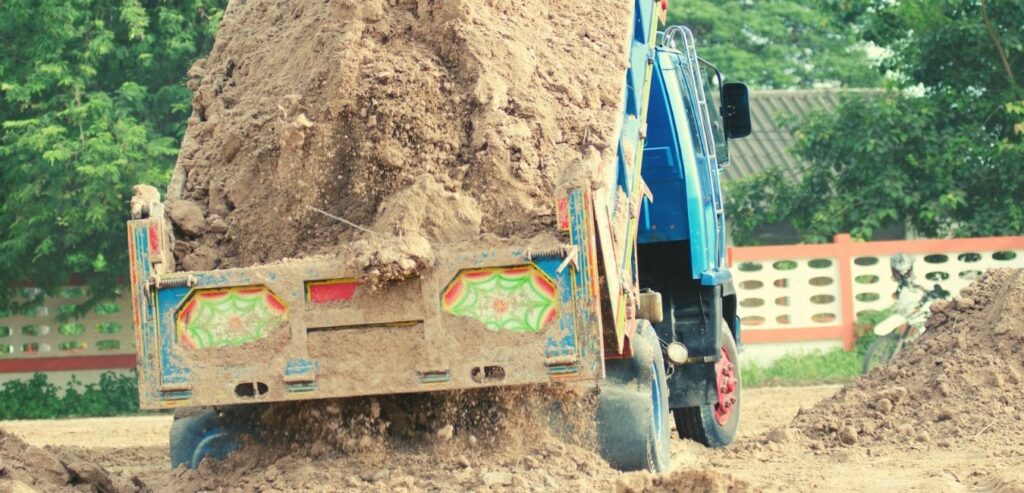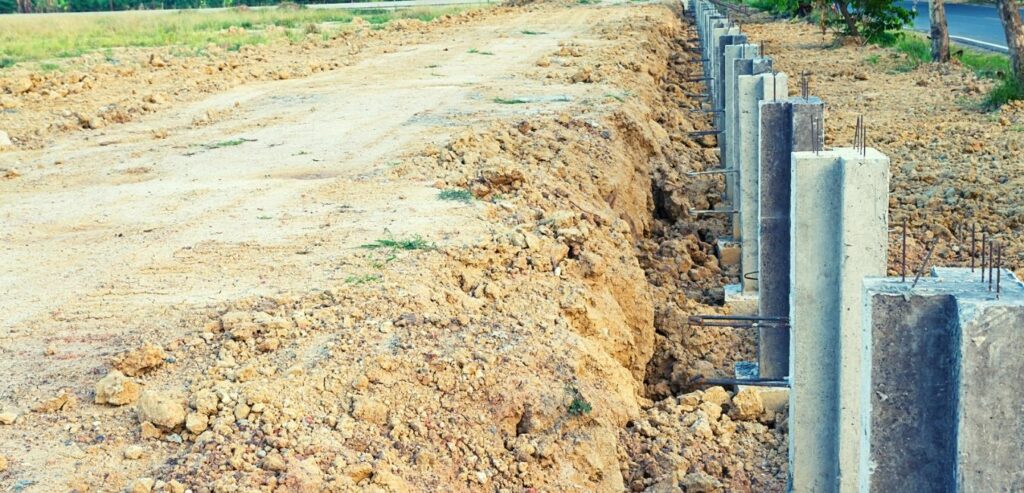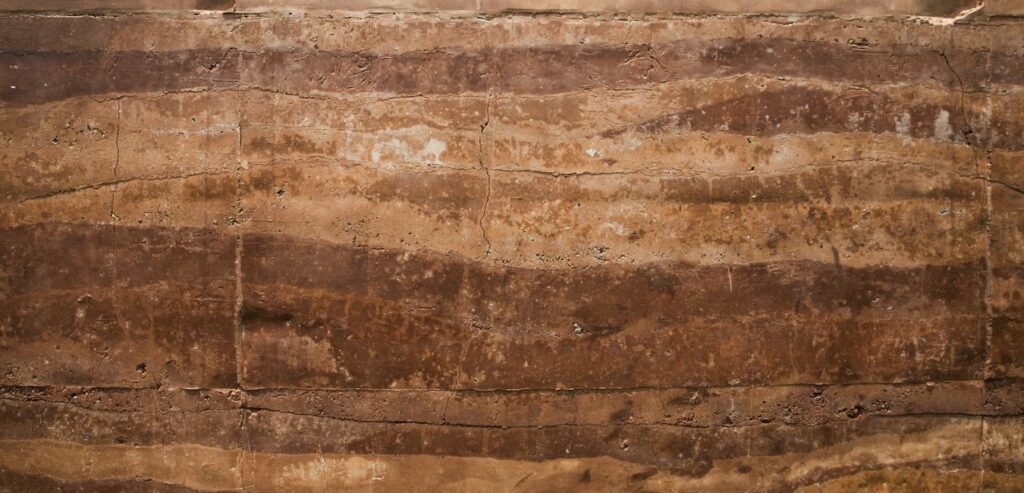Rammed earth is an ancient construction technique that resembles adobe or cob building. People in drier and hotter parts of the world used this design, and interest in this construction technique subsided in the 20th century after the dawn of reinforced concrete.
However, some still advocate for its use today, citing its aesthetics and perceived environmental benefits compared to modern construction techniques. Rammed earth structures are also made from local materials meaning they have little waste.
This article will discuss all you need to know about rammed earth construction.
Table of Contents
What is Rammed Earth Construction?
Rammed earth construction refers to ramming damp soil made from aggregate, sand, silt, clay, and gravel, into a formwork. The mixture is then compressed into a solid, and when it is dry, the formwork is removed to reveal monolithic walls.
The formwork needs to be strong enough to withstand the forces of ramming the earth. They also need to be easy to assemble and disassemble.
This technology was standard in drier and hotter parts of the earth. To work with rammed earth, you need to understand the climate and location where you will build the structure. The technology works best in humid environments with moderate temperatures.
For cold climates, rammed earth walls require additional insulation, whereas, in areas experiencing high rainfall, the walls need extra protection from the rain.
Most rammed earth structures exist in a basic form of compressed soil, but recently, builders add 5%-10% cement to the mix to increase the strength and durability. The appearance of rammed earth walls depends on the aggregates used and their color and texture.

A guide to Rammed Earth Construction
Below is a detailed guide on how rammed earth construction works.
Structure
Rammed earth is strong in compression and is considered suitable for load-bearing walls. One can introduce reinforcement similar to concrete to these walls, but it needs to be carefully done to reduce the difficulty of ramming around the bars or the risk of the walls cracking.
The first step is constructing the formwork. It is usually made from steel and covered with plywood to create an off-form finish as the rammed earth takes up the formwork's shape. The soil type determines the length of walls you can build in each setup.
Before setting up the formwork, you need to mark out where to build the walls, either on the slabs or concrete footings. It would be best to consider the overall aesthetics of the building and floor plan, and articulation joints between the walls.
The next step is preparing the mixture for the rammed earth. Primarily, there are two kinds of rammed earth: raw and stabilized. The raw mix is carefully mixed soil, while the stabilized mixture has some binder.
After mixing the rammed earth to correct moisture levels, it is placed in the formwork using a shovel and compacted using a pneumatic tamper until the mixture is compressed to half its original volume. This process is then repeated iteratively until the compacted earth fills the formwork. The compacted wall is left in the wall overnight for initial curing to occur before removing the formwork.
The formwork is then carefully removed to reveal the compressed earth wall. The contractor then repairs the minor imperfections, such as soil protruding through bolt holes.
Types of Formwork
Formwork is an integral part of rammed earth construction, and a well-structured formwork should withstand the entire ramming process.
There are mainly two types of formwork; movable and static. Other types are steel, system, and hybrid formworks.
Movable Formwork
Also known as horizontal formwork, movable formwork is popularly used in rammed-earth construction worldwide. The material is mainly plywood, which is light and easily maneuverable yet not too strong to deform the rammed earth wall.
Assembly and disassembly of the formwork are done rapidly with the controlled fixings between the two sides. Finally, the system uses wedges to tighten and loosen the formwork to unveil the wall.
Static Formwork
Static formwork in rammed earth construction is an ongoing process of assembling elements vertically to between 2-4m. Static formwork uses system-built formwork that can be hired or bought, saving on construction time needed to build the formwork from scratch. In addition, it is easier to access static formwork, making it quicker for contractors to build rammed earth walls.
Steel formwork
One must assess the weight and structure of steel formwork before placing the raw materials into the formwork. As the rammed wall is built a centimeter at a time, the steel formwork increases its pressure from one layer to another.
System formwork
System formwork works as a movable formwork with accessible panels, deep steel ribs, and an epoxy-bonded structure that makes it maneuverable. Although it is possible to slip form, the heavy weight of the system formwork needs to be checked to prevent issues when removing the state from the rammed earth wall system.
Hybrid formwork
Used mainly in Serbia and China, hybrid formwork uses vertical fixed sections to slip from sides to contain them. The ramming process happens quickly with the rammed materials, usually placed in long sections, becoming one single structure with zero joins.
Insulation
Rammed earth walls need to give thermal comfort, especially in areas with varying temperatures and humidity levels. These walls behave as heavy-weight masonry with a high thermal mass.
An important feature to consider during insulation is the wall's thermal mass, as it slows the movement of heat through the walls when the temperatures drop. It releases heat to the surrounding environment when the temperatures are high.
To enhance the thermal comfort of these walls, one needs to improve the airtightness and hygroscopic properties of the rammed earth. Insulating a rammed earth structure requires proper planning, as most builders prefer to leave the external face exposed for aesthetic reasons.
An obvious benefit of these structures is that they have a large thermal mass that helps store solar gains and buffer temperature changes. Insulation, therefore, needs to be done outside the structure since if it is done inside, a building loses all its thermal mass benefits. Insulating the wall from the outside also keeps the thermal mass within a controllable envelope. This increases the durability of the walls.
One way of providing this insulation is through plastering. You can also do it by adding the wall's thickness, but this changes the structural properties of the wall and increases overall construction costs.
The type and positioning of insulation also depend on the climatic conditions. It is worth noting that rammed earth is hygroscopic, and the walls can breathe to allow for evaporation. Therefore, the insulation finishes need to be vapor permeable to prevent moisture build-up within the assembly.
Durability
Rammed earth is generally very durable, as this technology has been around for hundreds of years. However, to maintain the integrity of these structures, one needs to keep moisture protection. Exposure to moisture reversed cement stabilization allowing the clays to expand, thus lowering the overall strength.
Therefore, the walls need to be shielded from weather elements as much as possible. The structure needs to have raised foundations that lift the wall at least 9 inches above the ground. The roof also needs overhangs to shield the walls from rain.
The structure's setup should allow the water to drain and evaporate quickly. Rammed earth walls are more suited to warmer areas since they have fewer moisture-related problems.

Environmental Benefits of Rammed Earth
Rammed earth walls have numerous benefits that make them great for construction without compromising quality. Below are some of the environmental benefits of rammed earth walls.
1. Eco-friendly
They also have very low embodied energy, meaning only a small amount of energy is necessary to construct the walls. Any waste materials can then be recycled or reused on the construction site.
These walls also have no cavities or materials that harbor pests, thus considerably increasing their pest resistance.
2. Low green-house emissions
In principle, rammed earth walls are a low greenhouse emission product. The emissions are primarily from the transport and manufacture, but these walls have very low emissions if construction is done using on-site materials.
They also have no flammable components, which help lower their overall emissions. Modern engineered rammed earth structures have considerably higher emissions than their traditional counterparts, but they generally have lower than concrete walls.
3. Breathability
People choose rammed earth walls because they 'breathe' and offer a healthy indoor environment. They allow for air inflow and outflow, thus efficiently helping combat humidity and maintain a stable internal temperature over the seasons. The finished walls are also inert and non-toxic.
4. Energy efficient
When properly constructed, rammed earth walls are very energy efficient. The thermal mass of these walls slows down the passage of heat through them and then releases the heat to the surrounding environment when the temperatures go down.
These energy savings minimize the need for heating and cooling systems.
5. Soundproof
Rammed earth walls are soundproof due to their density. This makes them suitable for areas experiencing continual sound pollution. They do not produce harsh echoes, which are a characteristic of most conventional wall materials.
Building several interior walls using rammed earth and combining them with double-pane windows can help create a unique quiet environment unlike any other.
6. Low maintenance
Rammed earth walls are generally low maintenance, and once built and sealed, they can take 10 to 20 years before needing further attention. There is no need for plaster or paint finish, and you can leave the bare walls exposed, forming a beautiful feature.
However, if you choose other kinds of finishing, they can be applied directly to the rammed earth surface like other masonry walls.
How much does it cost?
The overall costs of a rammed earth project depend on the project's site, design, fixtures and fittings, and project size. A rammed earth wall costs from $75 per square foot on average. The prices go up depending on the complexity of the wall. However, this does not include labor costs.
Most home builders using rammed earth keep the costs down by doing the work themselves. A rammed earth house can cost as much as a conventional house, as you will still need land to build on, permits, materials, appliances, and electric systems. However, they have money-saving features such as reduced energy consumption.
Pros of Rammed earth
Below are the pros of rammed earth construction.
Low maintenance
Well-constructed rammed earth walls are low maintenance and, once built and adequately cured, can stay approximately 10-20 years without needing any repair. In addition, its beautiful texture doesn’t need to be painted, making it easy to maintain.
Soundproof
The high density of rammed earth walls makes it soundproof. This characteristic is better suited for areas with a lot of noise pollution.
It is eco-friendly
Raw materials used to build rammed earth walls are non-toxic and reusable, so nothing goes to waste. In addition, these walls combine beautifully with the environment with their natural, earthy color, soil texture differentiation, and low greenhouse emission.
Allows for airflow
Rammed earth walls are quite breathable due to the easy inflow and outflow of air that provide a steady internal temperature while regulating humidity levels.
Impenetrable to most pests
Rammed earth walls have no cavities where pests can access or reside in. Therefore, once efficiently cured, it becomes impenetrable to most problems.
Cons of Rammed Earth
Below are the cons of rammed earth construction.
Construction costs may increase
Although rammed earth construction can be economical, if you start sourcing raw materials and employing laborers, the cost will increase significantly, making the final amount more than building a conventional home. There is also an added cost of buying and installing insulation required for all rammed earth constructions.
Has no long-term insulation
Rammed earth has a high thermal mass, making it a relatively poor insulator. Therefore, when constructing rammed earth, especially in colder climates, insulation needs to be correctly installed to make the indoor environment temperature comfortable.
Curing rammed earth takes a long time
The compressed rammed earth wall may look complete once the formwork is removed. However, it must be cured for approximately a month before it can be utilized. Any contractors using rammed earth as their primary material should account for the duration of curing as it takes up most of the project’s time.
Changes are hard to make after a wall is built
Mistakes made during the raming process can be hard to notice and challenging to rectify, especially after the wall is built.
Tedious approval process
As a traditional construction method in the United States, getting approval from bankers and insurance may require following a tedious approval process.
Conclusion
As you can see, there are lots to love about rammed earth walls. You can use them for both domestic and commercial buildings. They are versatile, and you can craft them to unique finishes that blend easily with other building materials.
They are also great for regulating humidity and temperature problems if the walls are left unclad. This is ideal for people with issues such as asthma.
These walls are among the few environmentally-friendly materials you can apply in construction, making your investment worth the expense. The usability of rammed earth construction depends on your location, but they are an easy way to build sustainable housing.

